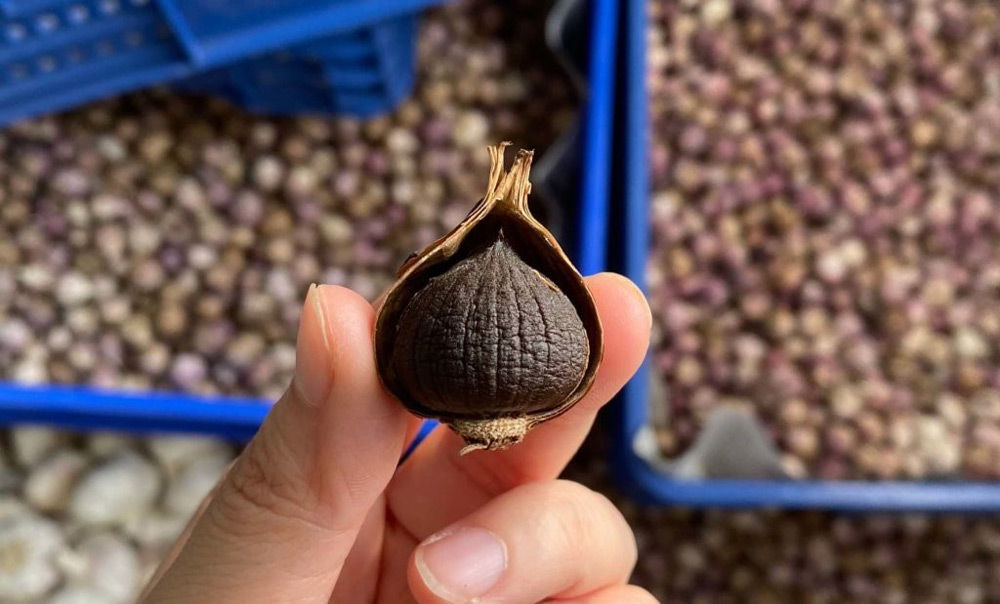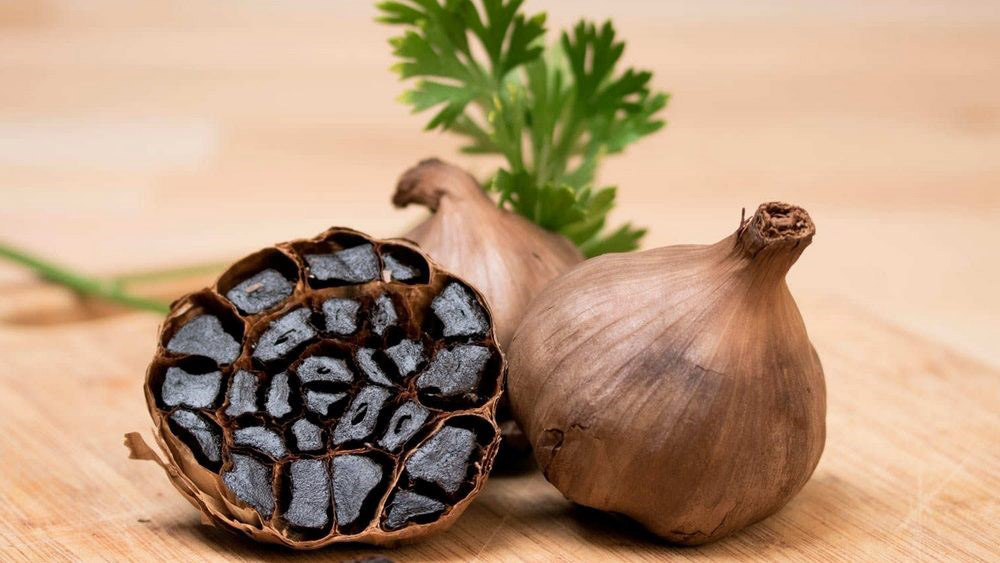Black garlic (BG) is simply fresh garlic (Allium sativum L.) that has been fermented for a period of time at a high temperature under high humidity. The process turns garlic cloves dark, gives them a sweet taste, and alters their consistency to chewy and jelly-like. The duration of fermentation varies depending on cultures, manufacturers, and purposes. The long history of the use of garlic in food and acute, chronic, and inhalation studies, although limited, reveals no credible adverse biological effects.
Exact origins of BG are unknown and controversial. However, BG has long been consumed in South Korea, Japan, and Thailand for centuries, and was introduced into Iran, Taiwan and other countries around 10 years ago.
In the past few years, high-end chefs have drawn much attention to BG, who have been using it to flavor chicken, fish, soup, and risotto.
When compared with fresh garlic, BG does not release a strong off-flavor due to the reduced content of allicin, which was converted into antioxidant compounds such as bioactive alkaloids and flavonoid compounds during the aging process.
The changes of physicochemical properties are the main reasons for enhanced bioactivity of BG compared with fresh garlic. Besides daily consumption, several studies have reported that BG extract demonstrates several functions, such as antioxidation, antiallergic, antidiabetes, antiinflammation, and anticarcinogenic effects.
In 1990, Designer Foods Program listed garlic at the top of cancer fighting candidates. Although the Designer Foods Program no longer exists, scientists are still looking for what are now called bioactive components in different foods.

Nutritional content of garlic
The enhanced biological activity of BG when compared with fresh garlic lies in the conversion of phytochemical compounds during the fermentation process. In the following section, we will summarize the changes of garlic components between fresh garlic and BG.
Comparison of the components between fresh garlic and BG
Fresh garlic contains approximately 63% of water, 28% of carbohydrate (fructans), 2.3% of organosulfur compounds, 2% of proteins (alliinase), 1.2% of free amino acids (arginine), and 1.5% of fiber.
Nontreated fresh garlic also contains a high amount of gamma-glutamylcysteines. These compounds can be hydrolyzed and oxidized to form alliin, which accumulates naturally during the storage of garlic at a cool temperature. After processing, such as cutting, crushing, chewing, or dehydration, alliinase rapidly lyses the cytotoxic cysteine sulfoxides (alliin) to form cytotoxic and odoriferous alkyl alkane-thiosulfinates such as allicin.
Allicin contributes to the characteristic flavor and taste of garlic. Allicin and other thiosulfinates are immediately decomposed to other compounds such as diallyl sulfide, diallyl disulfide, and diallyl trisulfide, dithiins, and ajoene.
At the same time, gamma-glutamylcysteines are converted to SAC through its catabolism pathway other than the alliin-eallicin pathway. SAC contributes to health benefits of garlic, such as its antidiabetic, antioxidant, and anti-inflammatory activities.
As for BG, during the thermal process, some chemical compounds from fresh garlic are converted into Amadori/Heyns compounds, which are key intermediate compounds of Maillard reaction. The chemical compounds of aged BG (ABG) are complicated, and the quality of its products depends on the manufacturing process. Nevertheless, BG contains much more functional compounds such as SAC than fresh garlic. The contents of chemical compounds of BG depend on the conditions during thermal processing. Some researchers reported that many valuable components within BG against diseases increased during the aging process, especially polyphenol, flavonoids, and some intermediates of Maillard reaction have been known as antioxidant agents Furthermore, the antioxidant activity of garlic varies across regions; nevertheless, BG demonstrates significantly much higher biological activity, such as antioxidant properties, than fresh garlic.
Several studies have reported that water-soluble sugars, amino acids, total polyphenols, and flavonoids increased or decreased during thermal processing.
|
|
Components of black garlic compared with fresh garlic |
Original concentration |
|
Water-soluble sugar |
Increased 1.88-7.91-fold |
450 mg/g |
|
Polyphenol |
Increased 4.19-fold |
13.91 mg GAE/g |
|
Flavonoid |
Increased 4.77-fold |
3.22 mg RE/g |
|
Amadori & Heyns |
Increased 40e100-fold |
10 mg/g |
|
Fructan |
Decreased 0.15e0.01-fold |
580 mg/g |
|
Leucine |
Increased 1.06-fold |
58.62 mg/100 g |
|
Isoleucine |
Increased 1.67-fold |
50.04 mg/100 g |
|
Cysteine |
Decreased 0.58-fold |
81.06 mg/100 g |
|
Phenylalanine |
Increased 2.43-fold |
55.64 mg/100 g |
|
Tyrosine |
Decreased 0.18-fold |
449.95 mg/100 g |
- GAE = gallic acid equivalents; RE = rutin equivalents.
Three of Amadori and three of Heyns compounds in BG increased significantlydup to 40e100-fold higher than those in fresh garlic. In contrast, through the aging process for converting fresh garlic to BG, the amount of fructans decreased simultaneously, owing to the fact that fructose and glucose with some of amino acids play important roles in Maillard reaction in garlic processing.
BG processing
Effects of aging temperature on the quality of BG
It is well known that the aging period of garlic is shorter at higher temperatures. In the case of aging process at 70ºC, the speed of aging is two-fold faster than that at 60ºC. According to sensory evaluation, the quality of BG is better and its black color is homogeneous between 70ºC and 80ºC. Even though BG is produced faster at 90ºC, it produces not ideal tastes, such as bitter and sour tastes. In the case of aging process at 60ºC, the color of garlic was not completely black; thus, 60ºC is also not an ideal condition for the aging process.
When the moisture content of garlic reaches 400e500 g/kg, BG can be suitable for eating because of its softness and elasticity. If moisture content is about 350e400 g/kg, BG would be much drier and its elasticity would be poor. In particular, when moisture content goes below 350 g/kg, BG becomes too hard to eat. Moreover, the aging speed of fresh garlic to BG is markedly slow when processed at 60ºC. Although aging occurs smoothly at 80ºC and 90ºC, an adequate condition is relatively difficult to find because of its fluctuating phenol content and reducing sugar content.
One of the main antioxidant compounds in BG is 5-hydroxymethylfurfural (5-HMF), and it is also an important intermediate product in Maillard reaction. Regardless of temperature, the amount of 5-HMF is increased during the aging process. However, in the case of processing at 60ºC, 5-HMF content increases very slowly during the whole process.
In summary, the aging period of BG is shorter at a high temperature; however, controlling the amount of some components might be difficult at a high temperature because their contents change rapidly during the aging process. Based on the results mentioned above, 70ºC is considered the best condition for garlic aging. However, the quality of BG is affected by not only temperature, but also other factors such as humidity and fermentation.
Physicochemical Properties of Black Garlic
The physicochemical characteristics of BG during the aging period are presented in Table. The total acid content of BG increased significantly compared to that of raw garlic, while the pH of BG significantly decreased from 5.49 to 3.74, when compared to 6.33 in raw garlic, during the aging period, therefore, the pH of BG decreased from 6.40 to 5.29 after 6 days of aging. The reducing sugar content of BG increased approximately 6-fold, from 2.73 g/kg on the 7th day to 16.07 g/kg on the 35th day, and these values were significantly higher than those of raw garlic (1.52 g/kg). This result show that sugar content (e.g., glucose, fructose, sucrose, and maltose) increased in BG compared to fresh and steamed garlic. Furthermore, this increased sugar content of BG might be related to its sweet taste.








